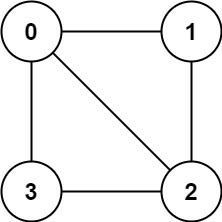There is an undirected graph with n nodes, where each node is numbered between 0 and n - 1. You are given a 2D array graph, where graph[u] is an array of nodes that node u is adjacent to. More formally, for each v in graph[u], there is an undirected edge between node u and node v. The graph has the following properties:
- There are no self-edges (
graph[u]does not containu). - There are no parallel edges (
graph[u]does not contain duplicate values). - If
vis ingraph[u], thenuis ingraph[v](the graph is undirected). - The graph may not be connected, meaning there may be two nodes
uandvsuch that there is no path between them.
A graph is bipartite if the nodes can be partitioned into two independent sets A and B such that every edge in the graph connects a node in set A and a node in set B.
Return true if and only if it is bipartite.
Input: graph = [[1,2,3],[0,2],[0,1,3],[0,2]] Output: false Explanation: There is no way to partition the nodes into two independent sets such that every edge connects a node in one and a node in the other.
Input: graph = [[1,3],[0,2],[1,3],[0,2]]
Output: true
Explanation: We can partition the nodes into two sets: {0, 2} and {1, 3}.
graph.length == n1 <= n <= 1000 <= graph[u].length < n0 <= graph[u][i] <= n - 1graph[u]does not containu.- All the values of
graph[u]are unique. - If
graph[u]containsv, thengraph[v]containsu.
use std::collections::HashSet;
impl Solution {
pub fn is_bipartite(graph: Vec<Vec<i32>>) -> bool {
let mut seen = HashSet::new();
let mut a = HashSet::new();
let mut b = HashSet::new();
for i in 0..graph.len() {
if !seen.contains(&i) {
let mut insert_a = true;
let mut nodes0 = vec![i];
while !nodes0.is_empty() {
let mut nodes1 = vec![];
for j in nodes0 {
seen.insert(j);
if insert_a {
a.insert(j);
} else {
b.insert(j);
}
for &k in &graph[j] {
if !seen.contains(&(k as usize)) {
nodes1.push(k as usize);
}
}
}
insert_a = !insert_a;
nodes0 = nodes1;
}
}
}
a.intersection(&b).count() == 0
}
}
